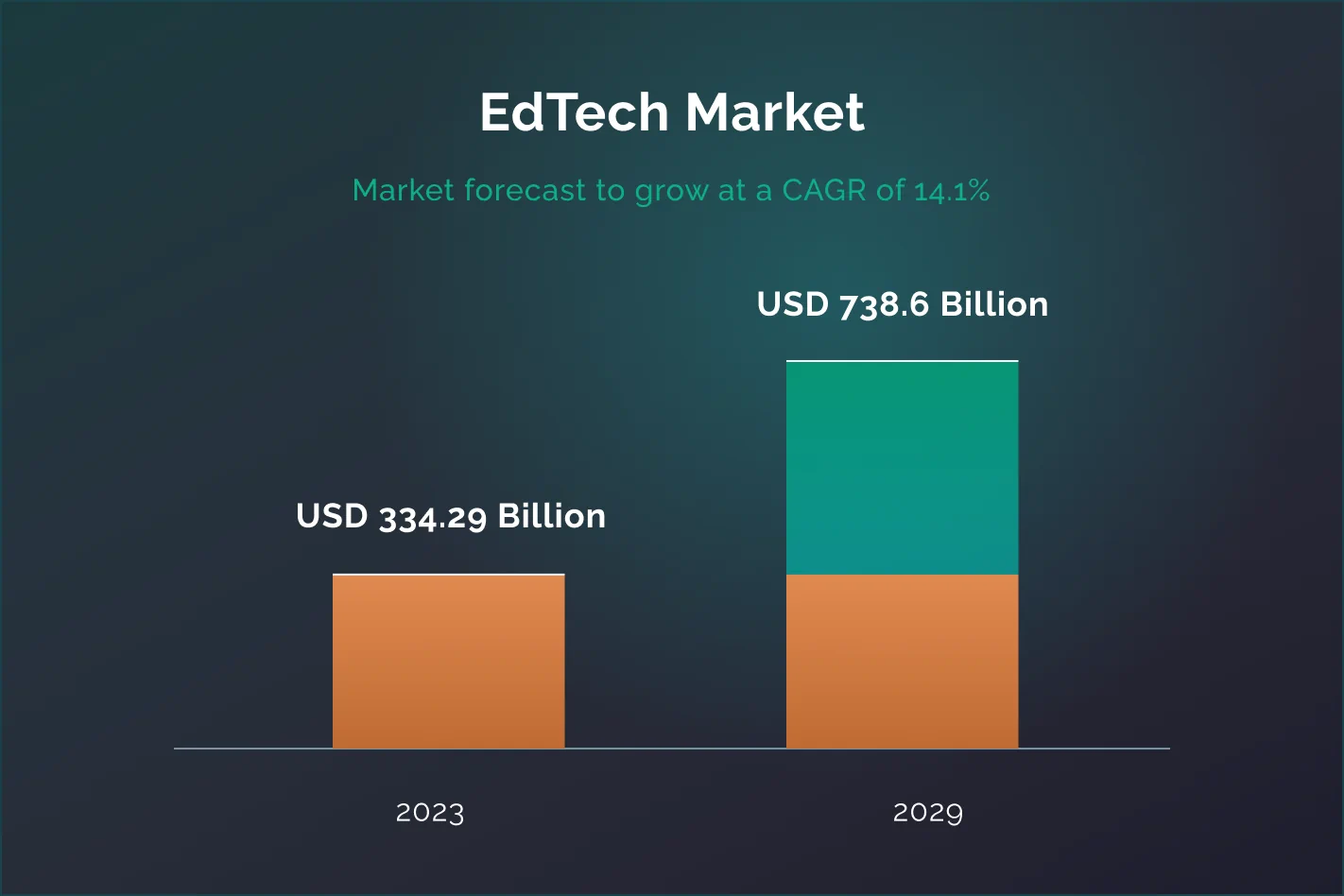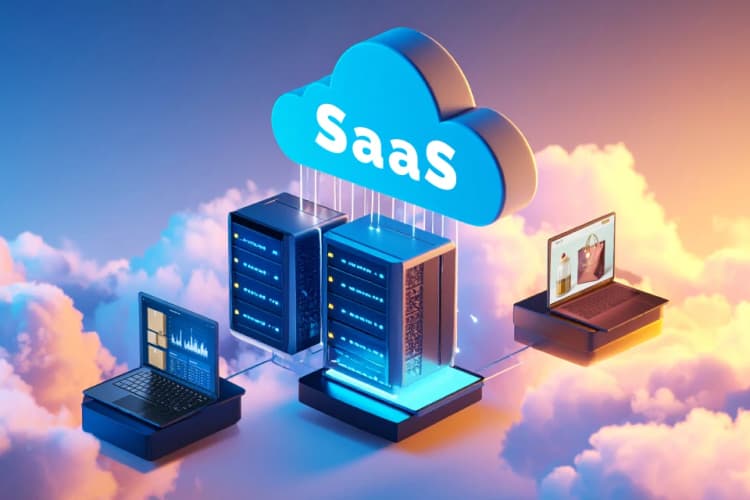Edtech Software Development: Challenges and Solutions

The contemporary edtech market is on a steep rise. While it was worth a little above $334 billion two years ago, it is forecasted to increase more than twofold by the end of 2029, manifesting a robust CAGR of 14+%.

The employment of edtech products in schools has grown by 99% within the last five years, and 79% of teachers use them daily. Given such impressive statistics, it is no wonder that edtech application development services are among the most-wanted offers from IT vendors today.
However, companies face numerous challenges in edtech app development while tackling such projects. This article lists common problems in edtech development and suggests solutions for edtech software issues supported by the best practices in this niche.
Key Challenges in Edtech Software Development in 2025

What are the edtech challenges software developers have to deal with during SDLC? Here are the main ones.
Scalability issues
Conventionally, educational institutions harness edtech products on a small scale but, satisfied with the first results, tend to augment their functionality roster and expand their utilization to involve larger audiences. The growth of user bases and the solution’s scope may negatively impact its performance and require additional bandwidth resources to handle greater data loads and manage high traffic. Such upscaling can be problematic if future-proofing isn't considered in the process of edtech product development.
Integration with existing systems
As a rule, tech-savvy educational establishments employ a ramified infrastructure containing a comprehensive learning management system combined with a variety of high-tech products and platforms, each relying on its own protocols and data types. Moreover, this ecosystem usually integrates different third-party tools connected via APIs. Embedding a new edtech solution into such an intricate environment is sure to cause compatibility issues.
Data security and privacy concerns
It is one of the most serious challenges of custom edtech software development. Why? Because educational organizations come to handle a slew of sensitive data, including personal information about teachers, students, and parents, grades learners receive, communications between stakeholders, etc. Compromising this data may inflict reputational damage and financial sanctions on organizations that fail to safeguard it. Moreover, schools and universities must comply with numerous regulations (COPPA, FERPA, GDPR, and others) that govern the standards of safe data collection, storage, and sharing.
User experience and accessibility
In edtech, the user base typically includes students of different ages, their parents with varying tech skills, and educators, some of them uncomfortable with using technologies in teaching. Therefore, creating a UX that works well for everyone is among the hardest edtech software development challenges. The complexity of educational workflows with all the steps and interactions and the need to ensure accessibility for all users, including those with disabilities, only adds to the challenge. Hence, you must ensure that your product’s UX design is up to the task of delivering to all the user groups involved.
Content quality and engagement
Garden-variety boring content that destroys students’ desire to learn is one of the most common issues in edtech software. Many edtech solutions don’t allow for the personalization of learning material and approaches, lack interactive and adaptive capabilities, neglect to update their content, and miss out on gamification features. Naturally, such products don’t kindle any interest of the user audience and keep their engagement below the freezing point.
Maintaining retention
Significant drop-off rates are a scourge of remote and online learning, which has gained widespread traction in our post-COVID world. This problem has its own reasons, but it is often directly related to the previous one. Failure to ensure long-term user engagement is symptomatic of many edtech projects implemented by educational establishments.
Budget constraints and funding issues
Innovative products are big-ticket items that are pricey to develop and acquire, while most educational establishments can't boast of having enough money to spare to invest in state-of-the-art software. Many of them struggle with devising cost-effective development strategies and forget to include profitable monetization models in the edtech solutions they onboard.
As you can see, both IT companies and educational organizations encounter multiple roadblocks and bottlenecks on the way to building and implementing edtech software. How can they handle them?
Solutions to Overcome Edtech Development Challenges

As a vetted vendor in the niche, Implex offers the following tips for overcoming challenges in edtech software development.
Hydrate the cloud
The scalability problem can be successfully addressed by envisaging the solution’s future expansion during the development process. Besides, the upscaling of an edtech product is ensured by switching from the on-premises to a cloud infrastructure. Cloud-based learning apps and systems not only guarantee their scalability on demand but also provide enhanced flexibility, rock-solid security, openness to customization, data management and analytics opportunities, and utmost cost efficiency.
Ensure seamless integration
Making sure that the newly created solution plays well with other elements of the organization's digital infrastructure is a tough row to hoe unless you adopt an API-first approach at the early stages of product development and leverage standardized compatibility protocols. Besides, the vendor should collaborate closely with the customer’s IT staff to get hold of the complete documentation concerning the existing ecosystem. This will enable software developers to obtain an in-depth understanding of the infrastructure and resolve issues as soon as they arise.
Implement strong data security measures
Data encryption and safe authentication are the cornerstones of edtech product security, protecting the inviolability of information at rest and in transit. Organizations should also perform regular security audits of their software to expose and patch vulnerabilities, introduce updates, and conduct penetration tests. Finally, your edtech solution will never win users’ trust without its adherence to legal norms that regulate data handling routines in the industry.
Leverage UI/UX design
It is not only about designing your product for different devices (desktop, laptop, mobile). It’s more about ensuring an inclusive experience for all learners, regardless of their abilities, backgrounds, or circumstances. Text zoom, screen reading, text-to-speech conversion, high-contrast themes, enlarged cursors, keyboard shortcuts, and other features will not only enable your app to reach more individuals but also showcase your organization as an institution with important social commitments. To learn more about accessibility characteristics, consult WCAG guidelines.
Prioritize student engagement
Trying to keep learners’ interest alive is a tall order for a software development company, as we discovered when we were building an education mob app for learning the Ukrainian language. An edtech solution should have a proper information design, enable interactive learning, and contain plenty of social features (private and public messaging, content sharing, comment sections, forums, etc.). Plus, you should involve experts in the domain to revise the content regularly and stay abreast of the current developments in the subject and novel approaches to teaching it.
Balance innovation and affordability
Realizing the high cost of edtech products, you should do your best to make them available to broad user audiences. As part of your cost optimization in software development, you can adopt lean development methodologies that allow software teams to create high-quality products without making the price tag exorbitant. Educational institutions should look for alternative sources of financing (such as crowdfunding, grants, collaborations, and more) and harness SaaS models and open-source solutions that enable them to push the technological envelope in their sector without paying through the nose for it.
Future Trends in Edtech Software Development

Find out what new developments will shape the future of edtech software solutions, setting new standards for innovation and accessibility.
Artificial intelligence
The rapid advent of AI-powered technologies (machine learning, computer vision, natural language processing, generative AI, and others) is revolutionizing workflows across multiple verticals, and the educational sector is no exception. In this realm, AI-driven tools are utilized for creating personalized learning experiences, automating grading, generating training materials, and processing real-time feedback, all of which allow educators to elevate their efforts to a new level.
Virtual and augmented reality
VR and AR solutions are second-to-none instruments for offering immersive learning and training. Using them, teachers can bring to life abstract scientific concepts, visualize studying “untouchable things” (for instance, human psychology, the universe, the planet's structure, and more), and provide hands-on 3D experience in anatomy, warehouse management, makeup, fashion, cooking, and other training domains.
Gamification
If you want to keep learners’ engagement high and dramatically augment knowledge acquisition, fill the edtech product with as many games as possible. Being one of the best practices for edtech software development, gamification paves the way for collaboration in classroom settings, fosters decision-making skills, improves problem-solving abilities, encourages peer-to-peer competition, and turns the learning process into an enjoyable and fun activity.
Microlearning
Sad as it may be to admit, contemporary people, largely nurtured by social networks with their YouTube shorts and TikTok videos, have mosaic thinking. As a result, their attention span holds for a brief time and can be captured only by something truly exciting and picturesque. Edtech products must live up to new-age learners’ expectations by structuring material in easily digestible small modules filled with interactive elements, virtual sessions, storytelling, and gratifications. Such an approach, known as microlearning, is becoming ever more popular, especially in corporate environments.
Conclusion
In the digitally savvy world of the 21st century, cutting-edge know-how has become the backbone of education. Yet, edtech software development and implementation face numerous obstacles, such as scalability, compatibility with other solutions, data privacy and security, accessibility, content quality, user retention and engagement, financial limitations, and more. They can be surmounted by hydrating the cloud, harnessing an API-first software development approach, relying on encryption and safe authentication techniques, prioritizing UX, enabling interactive learning, and making edtech products affordable for individuals and organizations.
However, all these measures can be effective only if you pay attention to emerging trends in the industry and entrust edtech projects to seasoned experts in the field. Qualified and certified professionals at Implex can build an edtech solution of any scope and complexity tailored to your unique needs. Drop us a line to revolutionize your teaching with disruptive technologies.



